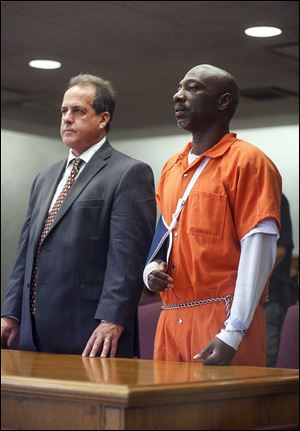
EDITORIAL
Dealing death has consequences
9/7/2018Lucas County Judge Dean Mandros did not pull any punches with a 47-year-old Toledo drug dealer who apologized for selling his friend a fatal dose of carfentanil.
“People that are selling drugs are selling poison,” Judge Mandros said before sentencing Frederick Emanuel to an additional three years in prison on top of the two-year sentence he’d given the man for drug trafficking. “You knowingly, willingly, for the purpose of making a few bucks helped put into circulation in this community, poison.”
Only a couple of years ago such cases rarely, if ever, resulted in charges for the people who sold or gave the drugs to overdose victims.

Frederick Emanuel is sentenced to three additional years for involuntary manslaughter for an overdose death.
It was difficult to track the sources of illicit drugs that killed users. And many in the public believed that because an overdose was a predictable risk for anyone taking drugs, drug users were responsible for their own choices, even when they were fatal.
As the opioid-addiction crisis took hold in Ohio, however, the state attorney general’s office began encouraging county prosecutors to file involuntary manslaughter charges against people who provide drugs on which someone overdoses.
Ohio was second only to West Virginia in the number of overdose deaths per capita in 2016.
The Centers for Disease Control and Prevention reported Ohio had 39.1 overdose deaths per 100,000 people that year, nearly double the national overdose death rate of 19.8 deaths per 100,000. That number was a sharp increase from 2015 when the CDC reported 29.9 deaths per 100,000 Ohio residents.
Some defense attorneys have pointed out that many of the drug-trafficking defendants they represent are scarcely more than fellow users who happen to have enough opioids to share. Many have no idea what other drugs their friends may have taken or even what may have adulterated the drugs they’re sharing. How is it fair to hold them accountable for a friend’s choice to use?
Demonizing addicts certainly is not a strategy that is going to make a dent in the crisis. Experts agree that effectively battling the crisis is going to require fights on multiple fronts — more prevention programs and education, better controls on the prescribing of narcotics, and more and better drug treatment and recovery support.
Ohio is not measuring up on any of these fronts, nor is it offering the support it should to cities, counties, school districts, and first responders on whom most of the opioid-crisis burden is falling.
But an effective strategy also will include a judicial system working to get drug dealers off the streets. Judges who rightly hold dealers responsible for their customers’ deaths are playing their part in the fight against opioids.
The demand for these deadly drugs is the root of the scourge, but Ohio’s law enforcement and courts must also do whatever is possible to interrupt their supply.
Holding the dealers responsible for overdose deaths they cause can save lives. Maybe it will be the life of their would-be next customer. Maybe it is even the life of the dealer himself.